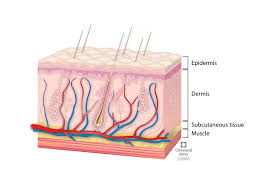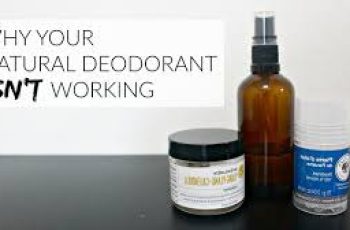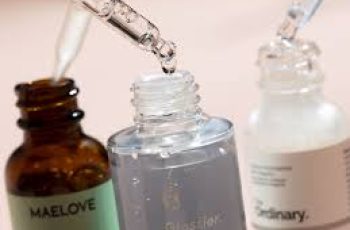
Layers of Human Skin
How many layers are in human skin?
The 8 main layers of the skin.
How many layers the skin has depends upon what area of the body you are in.
Most of the surface area of the human body has 7-8 layers of skin.
The 8 layers of the skin are (from top to bottom):
Stratum corneum (SC)
Stratum lucidum (only in palms and soles)
Stratum granulosum (Granular layer)
Stratum spinosum
Basal Layer (deepest layer of the epidermis)
Papillary Dermis
Reticular Dermis
Hypodermis/ Fat layer
How many layers does the epidermis of the skin have?
The epidermis has 4- 5 layers of skin.
The palms and soles have 5 layers which include a stratum lucidum.
The rest of the skin does not have a stratum lucidum and only has 4 layers.
The lip skin has a very thin stratum corneum that is hardly a layer at all. In fact, some say the lip does not have a statum corneum- but the lip does have 2-3 cell layers on the surface that can be considered the stratum corneum.
How many layers does the dermis of the skin have?
The dermis has two layers:
the reticular dermis
the papillary dermis
Where are stem cells found in human skin?
The skin is made of two main layers: the epidermis and the dermis. Each has a different type of stem cell.
The reticular dermis has stem cells with different characteristics than the stem cells in the papillary dermis.
The stem cells in the dermis move around but tend to stay in their own section of the dermis. [1]
Which layer of the skin has the skin barrier?
The skin barrier is found in the stratum corneum layer of the epidermis.
What skincare ingredients can penetrate the skin layers?
Peptides, stem cells, collagen, elastin and other ingredients in skincare products cannot penetrate into the skin and are a waste of money [2].
The reasons that these ingredients cannot penetrate the skin are usually because they are too big or too hydrophilic.
Even if peptides, stem cells, collagen and elastin are placed in nanotechnology or other delivery devices, they cannot penetrate into the skin.
This is why many researchers are trying to use micro-needling techniques to increase the penetration of stem cells and peptides into the skin.
What skincare ingredients penetrate into the epidermis?
Most skincare ingredients can only penetrate into the uppermost layers of the epidermis.
This is because the skin barrier is designed to keep things out.
Skincare products such as sunscreens, moisturizers, hydrating facial serums with humectants and exfoliants target the epidermis and do not need to get into the dermis to have a beneficial effect.
What skincare ingredients penetrate into the dermis?
To have an effect on wrinkles and skin pigmentation, skincare ingredients must penetrate into the dermis.
Very few cosmetic ingredients can penetrate into the dermis of the skin because only ingredients smaller than 500 Da [3] can penetrate into the dermis of the skin.
Some skincare ingredients, such as defensins, can get into the skin via the hair follicle.
Hormones and retinoids can penetrate easily into the dermis of the skin. Hyaluronic acid fragments smaller than 500 Da can penetrate into the skin, but longer HA chains cannot [4]. The vast majority of peptides are larger than 500 Da and cannot penetrate into the skin.
Which moisturizers penetrate into the skin?
Humectants can penetrate into the upper layers of the epidermis.
Occlusive moisturizers stay on the skin’s surface.
The lipids in barrier repair moisturizers can penetrate into the upper layers of the epidermis to repair the skin barrier.
Moisturizing oils may penetrate into the skin depending upon what types of fatty acids they contain. (See oil discussion below.)
Moisturizers do not penetrate into the dermis, however, the epidermis layer is responsible for skin hydration and is the target of moisturizing ingredients.
Which serums penetrate into the skin?
Hyaluronic acid serums made of low molecular weight HA (short chains of HA) penetrate into the epidermis and can help other ingredients penetrate into the
epidermis. HA is known as a penetration enhancer ingredient [6], however, HA does not penetrate all the way to the dermis. The only serums that penetrate into the dermis are retinoid serums and hormone-containing serums such as estrogen and testosterone.
Which oils penetrate into the layers of the skin?
The depth of an oil’s penetration into the skin depends upon the type of fatty acid in the oil. Oleic acid is a monounsaturated fatty acid found in olive oil. It is the fatty acid that penetrates most into the skin. The use of olive oil and other oils with oleic acid can disrupt the skin barrier and lead to an increased risk of allergy and skin dehydration. Oleic acid is often added to topical drugs to increase skin penetration. One study [7] that compared the penetration of oils in the skin found that oleic acid penetrated the most, followed (in order of how much penetration the oil had) by coconut oil, grape seed oil, and avocado oil. Emu oil penetrated the least. Oils do not need to penetrate into the dermis to have beneficial effects. Stearic Acid, the fatty acid, is found in many cosmetic ingredients and oils and can help repair the skin barrier when combined with the correct amount of other lipids.
Which sunscreens penetrate into the skin?
Since there are many factors that can influence the penetration of sunscreen into the deep layers of the skin, each sunscreen must be tested individually. Chemical sunscreens are more likely to penetrate into deeper layers of the skin than mineral sunscreens do. One study compared different sunscreen ingredients and found that many chemical sunscreens only penetrate superficial layers of the skin, but benzophenone was able to penetrate to deeper layers. [8]
Physical mineral sunscreens that contain zinc oxide and titanium dioxide stay mainly on the surface of the skin and reflect away UV rays. This is one reason why mineral sunscreens look so white on the skin’s surface.
As you can see, there are many layers of the skin, and each plays an important role. The granular layer of the epidermis is a particularly interesting skin layer because the granules seen in this layer are little factories that are making lipids, keratin, filaggrin, loricrin and other building blocks of the skin. When these granular factories unload their contents into the cell or between cells, the granules disappear. This is why you do not see granules in the stratum corneum layer of the skin.
Although you do not need to understand all the layers of the skin to be a skincare expert, it is important to realize that the skin is designed to keep things out (except hormones), and most cosmetic ingredients just do not penetrate very deep in the skin. Penetration of skincare ingredients and the effects of combining ingredients on penetration are important considerations when developing a skincare regimen.
Optimizing the delivery of cosmeceutical ingredients to improve efficacy is the art and science of skincare routine design.
Take our quiz to find out which skin type you are and to get a skin care routine.


